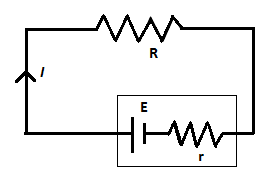
A current of 2 A flows through the\[2\,\Omega \] resistor when connected across a battery. The same battery supplies a current of 0.5 A when connected across a \[9\,\Omega \] resistor. The internal resistance of the battery is
A. \[1/3\,\Omega \]
B. \[1/4\,\,\Omega \]
C. \[1\,\Omega \]
D. \[0.5\,\Omega \]
Answer
556.2k+ views
Hint: Draw the circuit diagram containing external resistor and battery. Apply Kirchhoff’s voltage law and express the current in the circuit. Again express the current in the circuit for the second case and solve these two equations to determine the internal resistance of the battery.
Formula used:
Ohm’s law,
\[V = IR\]
Here, V is the voltage, I is the current and R is the resistance.
Complete step by step answer:
Let’s draw the circuit diagram containing battery and resistor as shown in the figure below,

In the above figure, R is the external resistor connected across the battery and r is the internal resistance of the battery.
Now, let’s apply Kirchhoff’s voltage law to the above circuit as follows,
\[E - IR - Ir = 0\]
\[ \Rightarrow IR + Ir = E\]
\[ \Rightarrow I = \dfrac{E}{{R + r}}\] …… (1)
This is the current in the circuit when the\[2\,\Omega \] resistor is connected across the battery. Now let’s express the current in the circuit when \[9\,\Omega \] resistor is connected across the battery as follows,
\[I' = \dfrac{E}{{R' + r}}\] …… (2)
Dividing equation (1) and equation (2), we get,
\[\dfrac{I}{{I'}} = \dfrac{{\dfrac{E}{{R + r}}}}{{\dfrac{E}{{R' + r}}}}\]
\[ \Rightarrow \dfrac{I}{{I'}} = \dfrac{{R' + r}}{{R + r}}\]
Substituting 2 A for I, 0.5 A for \[I'\], \[2\,\Omega \] for R and \[9\,\Omega \] for \[R'\] in the above equation, we get,
\[\dfrac{2}{{0.5}} = \dfrac{{9 + r}}{{2 + r}}\]
\[ \Rightarrow 4 = \dfrac{{9 + r}}{{2 + r}}\]
\[ \Rightarrow 8 + 4r = 9 + r\]
\[ \Rightarrow 3r = 1\]
\[ \therefore r = 1/3\,\Omega \]
Therefore, the internal resistance of the battery is \[1/3\,\Omega \].
So, the correct answer is “Option A”.
Note:
In equation (2), the internal resistance of the battery r does not change with changing the value of external resistance R. Students don’t need to apply Kirchhoff’s law to express the current in the circuit. You can memorize the formula (1) to calculate the internal resistance of the battery. If multiple resistors are connected in the circuit then calculate the equivalent resistance of the circuit.
Formula used:
Ohm’s law,
\[V = IR\]
Here, V is the voltage, I is the current and R is the resistance.
Complete step by step answer:
Let’s draw the circuit diagram containing battery and resistor as shown in the figure below,

In the above figure, R is the external resistor connected across the battery and r is the internal resistance of the battery.
Now, let’s apply Kirchhoff’s voltage law to the above circuit as follows,
\[E - IR - Ir = 0\]
\[ \Rightarrow IR + Ir = E\]
\[ \Rightarrow I = \dfrac{E}{{R + r}}\] …… (1)
This is the current in the circuit when the\[2\,\Omega \] resistor is connected across the battery. Now let’s express the current in the circuit when \[9\,\Omega \] resistor is connected across the battery as follows,
\[I' = \dfrac{E}{{R' + r}}\] …… (2)
Dividing equation (1) and equation (2), we get,
\[\dfrac{I}{{I'}} = \dfrac{{\dfrac{E}{{R + r}}}}{{\dfrac{E}{{R' + r}}}}\]
\[ \Rightarrow \dfrac{I}{{I'}} = \dfrac{{R' + r}}{{R + r}}\]
Substituting 2 A for I, 0.5 A for \[I'\], \[2\,\Omega \] for R and \[9\,\Omega \] for \[R'\] in the above equation, we get,
\[\dfrac{2}{{0.5}} = \dfrac{{9 + r}}{{2 + r}}\]
\[ \Rightarrow 4 = \dfrac{{9 + r}}{{2 + r}}\]
\[ \Rightarrow 8 + 4r = 9 + r\]
\[ \Rightarrow 3r = 1\]
\[ \therefore r = 1/3\,\Omega \]
Therefore, the internal resistance of the battery is \[1/3\,\Omega \].
So, the correct answer is “Option A”.
Note:
In equation (2), the internal resistance of the battery r does not change with changing the value of external resistance R. Students don’t need to apply Kirchhoff’s law to express the current in the circuit. You can memorize the formula (1) to calculate the internal resistance of the battery. If multiple resistors are connected in the circuit then calculate the equivalent resistance of the circuit.
Recently Updated Pages
Master Class 12 Economics: Engaging Questions & Answers for Success

Master Class 12 Maths: Engaging Questions & Answers for Success

Master Class 12 Biology: Engaging Questions & Answers for Success

Master Class 12 Physics: Engaging Questions & Answers for Success

Basicity of sulphurous acid and sulphuric acid are

Master Class 12 Business Studies: Engaging Questions & Answers for Success

Trending doubts
What are the major means of transport Explain each class 12 social science CBSE

Which are the Top 10 Largest Countries of the World?

Draw a labelled sketch of the human eye class 12 physics CBSE

How much time does it take to bleed after eating p class 12 biology CBSE

Explain sex determination in humans with line diag class 12 biology CBSE

Differentiate between homogeneous and heterogeneous class 12 chemistry CBSE




